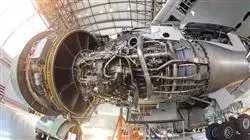University certificate
Scientific endorser

The world's largest faculty of engineering”
Introduction to the Program
Learn to design, evaluate and manage Mechanical Engineering projects, incorporating the most relevant and interesting innovations in the sector"

The incursion of new technologies in Mechanical Engineering demands professionals with extensive digital skills"
TECH's Professional master’s degree in Mechanical Engineering is a program specifically designed for professionals who need to strengthen their knowledge, both in the conventional aspects of their professional activity, as well as in the most innovative aspects.
It has an international focus, with content based on that of the most prestigious universities in the world and is aligned with the recommendations of professional associations such as ASME (American Society of Mechanical Engineers) and IMechE (Institution of Mechanical Engineers).
The use of the case method facilitates the learning of concepts, avoiding systematic memorization and repetitive performance of complex calculations.
The content of the program combines the traditional but necessary aspects of the profession with the most innovative aspects that are renewed in each edition.
We can highlight the aspects related to innovation management and Soft Skills, which accompany the different modules of the program, as well as the study of Industry 4.0 solutions, applied to Mechanical Engineering and the development of optimized processes of total quality, applied to all steps of mechanical design; without forgetting the use of simulation tools, freely available, which facilitate the performance of calculations, and allow to analyze solutions much solutions in much greater detail.
It should be noted that, as it is a 100% online program, the student is not conditioned by fixed schedules or the need to move to another physical location, but can access the contents at any time of the day, balancing their work or personal life with their academic life.
This Professional master’s degree may be the best investment you can make in the selection of a refresher program for two reasons: in addition to updating your knowledge in Mechanical Engineering, you will obtain a certificate from TECH Global University"
This Professional master’s degree in Mechanical Engineering contains the most complete and updated educational program on the market. The most important features of the program include:
- The development of case studies presented by experts in Mechanical Engineering
- The graphic, schematic and eminently practical contents with which they are conceived, gather scientific and practical information on those disciplines that are essential for professional practice
- Practical exercises where the self-assessment process can be carried out to improve learning
- Its special emphasis on innovative methodologies in Mechanical Engineering
- Theoretical lessons, questions to the expert, debate forums on controversial topics, and individual reflection assignments
- Content that is accessible from any fixed or portable device with an Internet connection
It includes, in its teaching staff, professionals belonging to the field of Mechanical Engineering, who pour into this training the experience of their work, in addition to recognized specialists, reference societies and prestigious universities.
The multimedia content, developed with the latest educational technology, will provide the professional with situated and contextual learning, i.e., a simulated environment that will provide immersive training , programmed to train in real situations.
This program is designed around Problem Based Learning, whereby the professional must try to solve the different professional practice situations, that arise during the academic year. For this purpose, the professional will be assisted by an innovative interactive video system created by renowned and experienced experts in Mechanical Engineering, adding their extensive valued experience.
A complete didactic material, totally accessible, that will allow you to study with comfort, expanding your knowledge in the most stimulating way"

This program, 100% online, will allow you to combine your studies with your professional work. You choose where and when to train"
Why study at TECH?
TECH is the world’s largest online university. With an impressive catalog of more than 14,000 university programs available in 11 languages, it is positioned as a leader in employability, with a 99% job placement rate. In addition, it relies on an enormous faculty of more than 6,000 professors of the highest international renown.

Study at the world's largest online university and guarantee your professional success. The future starts at TECH”
The world’s best online university according to FORBES
The prestigious Forbes magazine, specialized in business and finance, has highlighted TECH as “the world's best online university” This is what they have recently stated in an article in their digital edition in which they echo the success story of this institution, “thanks to the academic offer it provides, the selection of its teaching staff, and an innovative learning method aimed at educating the professionals of the future”
A revolutionary study method, a cutting-edge faculty and a practical focus: the key to TECH's success.
The most complete study plans on the university scene
TECH offers the most complete study plans on the university scene, with syllabuses that cover fundamental concepts and, at the same time, the main scientific advances in their specific scientific areas. In addition, these programs are continuously being updated to guarantee students the academic vanguard and the most in-demand professional skills. In this way, the university's qualifications provide its graduates with a significant advantage to propel their careers to success.
TECH offers the most comprehensive and intensive study plans on the current university scene.
A world-class teaching staff
TECH's teaching staff is made up of more than 6,000 professors with the highest international recognition. Professors, researchers and top executives of multinational companies, including Isaiah Covington, performance coach of the Boston Celtics; Magda Romanska, principal investigator at Harvard MetaLAB; Ignacio Wistumba, chairman of the department of translational molecular pathology at MD Anderson Cancer Center; and D.W. Pine, creative director of TIME magazine, among others.
Internationally renowned experts, specialized in different branches of Health, Technology, Communication and Business, form part of the TECH faculty.
A unique learning method
TECH is the first university to use Relearning in all its programs. It is the best online learning methodology, accredited with international teaching quality certifications, provided by prestigious educational agencies. In addition, this disruptive educational model is complemented with the “Case Method”, thereby setting up a unique online teaching strategy. Innovative teaching resources are also implemented, including detailed videos, infographics and interactive summaries.
TECH combines Relearning and the Case Method in all its university programs to guarantee excellent theoretical and practical learning, studying whenever and wherever you want.
The world's largest online university
TECH is the world’s largest online university. We are the largest educational institution, with the best and widest online educational catalog, one hundred percent online and covering the vast majority of areas of knowledge. We offer a large selection of our own degrees and accredited online undergraduate and postgraduate degrees. In total, more than 14,000 university degrees, in eleven different languages, make us the largest educational largest in the world.
TECH has the world's most extensive catalog of academic and official programs, available in more than 11 languages.
Google Premier Partner
The American technology giant has awarded TECH the Google Google Premier Partner badge. This award, which is only available to 3% of the world's companies, highlights the efficient, flexible and tailored experience that this university provides to students. The recognition as a Google Premier Partner not only accredits the maximum rigor, performance and investment in TECH's digital infrastructures, but also places this university as one of the world's leading technology companies.
Google has positioned TECH in the top 3% of the world's most important technology companies by awarding it its Google Premier Partner badge.
The official online university of the NBA
TECH is the official online university of the NBA. Thanks to our agreement with the biggest league in basketball, we offer our students exclusive university programs, as well as a wide variety of educational resources focused on the business of the league and other areas of the sports industry. Each program is made up of a uniquely designed syllabus and features exceptional guest hosts: professionals with a distinguished sports background who will offer their expertise on the most relevant topics.
TECH has been selected by the NBA, the world's top basketball league, as its official online university.
The top-rated university by its students
Students have positioned TECH as the world's top-rated university on the main review websites, with a highest rating of 4.9 out of 5, obtained from more than 1,000 reviews. These results consolidate TECH as the benchmark university institution at an international level, reflecting the excellence and positive impact of its educational model.” reflecting the excellence and positive impact of its educational model.”
TECH is the world’s top-rated university by its students.
Leaders in employability
TECH has managed to become the leading university in employability. 99% of its students obtain jobs in the academic field they have studied, within one year of completing any of the university's programs. A similar number achieve immediate career enhancement. All this thanks to a study methodology that bases its effectiveness on the acquisition of practical skills, which are absolutely necessary for professional development.
99% of TECH graduates find a job within a year of completing their studies.
Professional Master's Degree in Mechanical Engineering
The constant innovation and modernization regarding the technological and methodological possibilities of mechanical engineering demand from the specialized professional a continuous training based on the relevant theoretical and practical updating in the most recent fundamental novelties for the optimal development of the work of such engineering. Understanding the latent need for educational processes according to the current requirements of the sector, at TECH Global University we have designed our Professional Master's Degree in Mechanical Engineering, focused on the qualification of the professional in the current tendencies of the sector. This postgraduate program also has a special emphasis on aspects related to the management of engineering projects, and on the new technological and procedural possibilities encompassed in the concept of mechanics 4.0.
Study a Professional Master's Degree in Mechanical Engineering completely online
Due to its extensive field of action there is currently a great labor demand for professionals specialized in mechanical engineering. In our Professional Master's Degree, through a modular educational process designed under the current requirements of the sector, you will acquire all the tools, knowledge and skills necessary for the correct labor development of the practice of mechanical engineering. In this way, the professional's knowledge is up to date in concepts as relevant as: the new methodological alternatives regarding the planning and development of thermal, hydraulic and pneumatic machines; the particularities corresponding to the design for safety, reliability and environmental care; and the importance of the knowledge of the possibilities offered by the use of biomaterials and nanomaterials in manufacturing processes.







